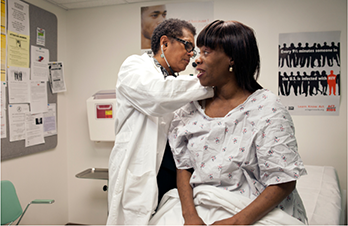2017
HIV and Hepatitis C Coinfection: HRSA Progress and Efforts Around Curing Hepatitis C Among People Living With HIV
Approximately one in five people living with HIV (PLWH) is coinfected with the hepatitis C virus (HCV), and hepatitis C-related liver disease has become one of the leading causes of non-AIDS-related death among PLWH. Viral hepatitis is particularly insidious for PLWH because the disease progresses faster and causes more liver-related health problems in this population than among those who do not have HIV. On a hopeful note, the development of direct-acting antiviral (DAA) therapies that have the ability to cure HCV offers an exciting opportunity to eliminate HCV and prevent one of the main causes of non-AIDS-related death among PLWH.
As a result of the seriousness of this health threat and the relatively common rate of coinfection, beginning in 2016, the Health Resources and Services Administration’s (HRSA) Ryan White HIV/AIDS Program launched increased efforts related to curing HCV, setting elimination of HIV/HCV coinfection as one of its goals. To meet this goal, the Ryan White HIV/AIDS Program has undertaken several critical initiatives to increase HCV screening and treatment among its clients, specifically among people of color living with HIV. The Ryan White HIV/AIDS Program supports a variety of medical services and treatments that cure HCV coinfection, and the majority of states, plus Washington, D.C. and Puerto Rico, make DAA therapies available to coinfected individuals through the Ryan White HIV/AIDS Program Part B AIDS Drug Assistance Program.1 Additionally, HRSA undertook a study to identify and understand the barriers to receiving HCV treatment among PLWH as a step toward developing the most effective strategies to overcome these barriers.2
HRSA’s HIV/AIDS Bureau (HAB) has also funded two initiatives to better understand how to best support the national effort to eliminate HIC/HCV coinfection at the jurisdictional level. In the first initiative, HRSA/HAB provided resources to three cities and two states to increase capacity among providers and clinics to provide comprehensive HCV screening, care, and treatment for PLWH through the Secretary’s Minority AIDS Initiative Fund (commonly known as SMAIF). This additional funding increases the number of HIV/HCV-coinfected people of color who are diagnosed, treated, and cured of HCV infection and will provide valuable lessons learned and best practices that can be spread to other jurisdictions across the nation. The Evaluation and Technical Assistance Center and a State Health Departments Coordinating Center, each established to help these jurisdictions in their efforts, provide technical assistance, multisite evaluation, and dissemination of best practices and lessons learned from the initiative.1
A second initiative has similar goals and funded two jurisdictions with emphasis on expanding partnerships to include a focus on building capacity for HCV surveillance in health departments and improve coordination with the Substance Abuse and Mental Health Services Administration’s funded substance use disorder (SUD) treatment providers to deliver behavioral health and SUD treatment support to achieve treatment completion and prevent HCV infection and re-infection. As with the first initiative, an important goal is to develop a model of response that can be replicated nationally.3 This initiative is also supported through SMAIF.
To increase provider knowledge about HIV/HCV coinfection, the Ryan White HIV/AIDS Program Part F AIDS Education and Training Centers Program National Coordinating Resource Center launched a free, online “HIV/HCV Co-infection: An AETC National Curriculum” to train health care providers and health educators on HIV/HCV coinfection in 2017. The curriculum includes prevention, screening, diagnosis, and treatment recommendations.4
HRSA, HAB, and the Ryan White HIV/AIDS Program remain committed to improving the health of PLWH and will continue to implement innovative efforts aimed at eliminating HCV.
 Health Resources & Services Administration
Health Resources & Services Administration


